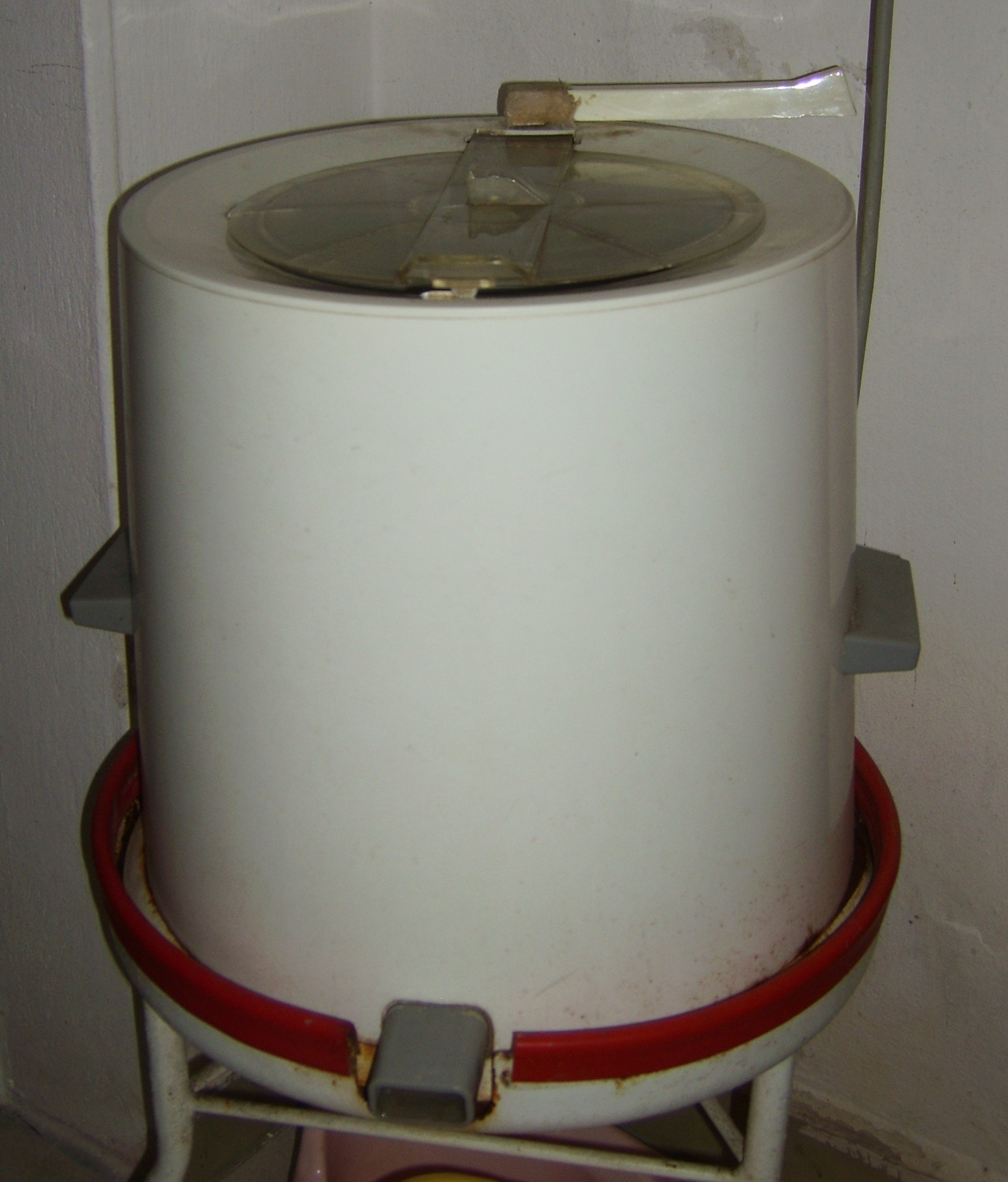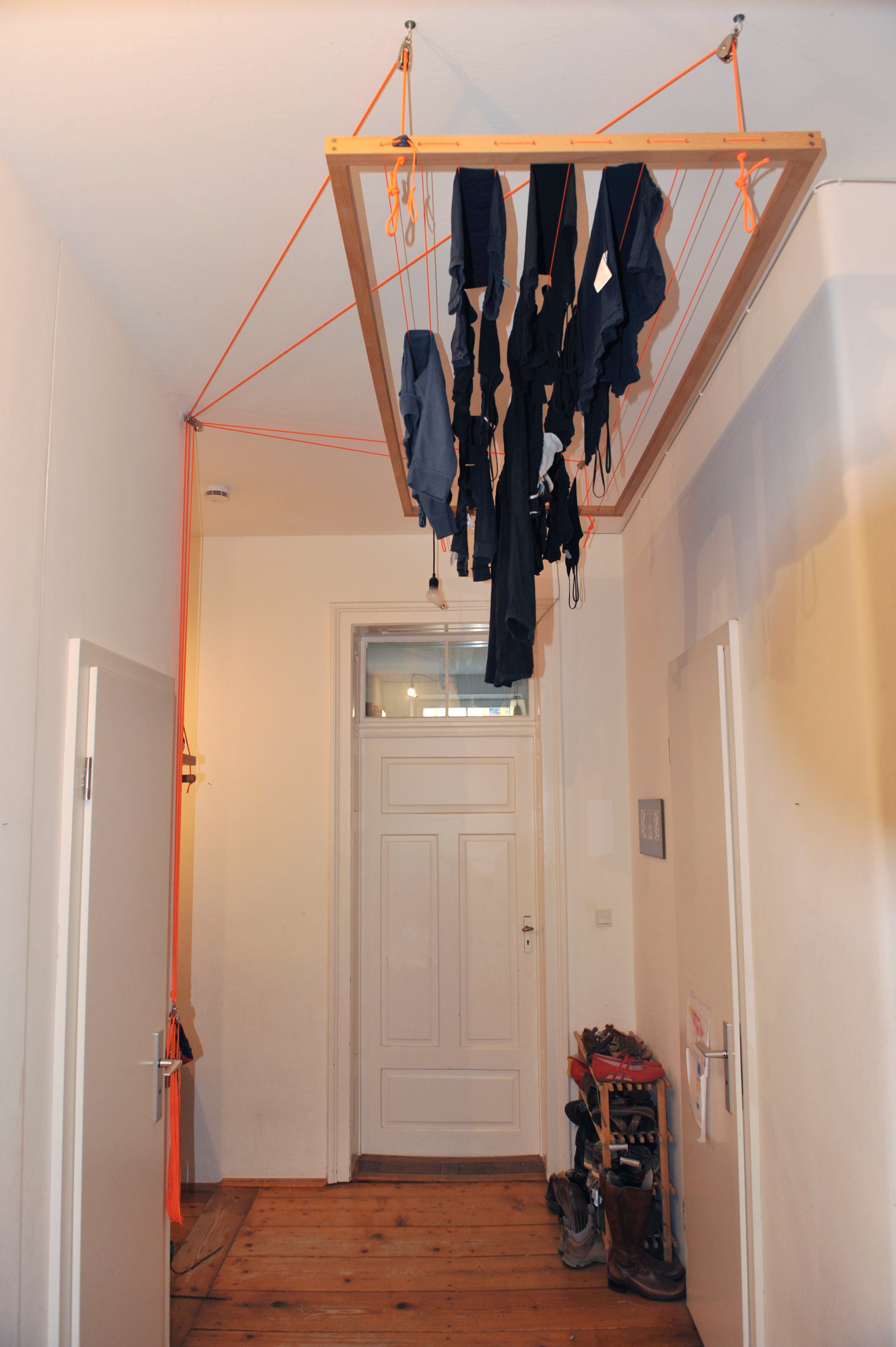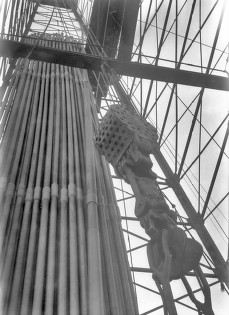|
Drying Rack
The term 'clothes horse' is used to refer to a portable frame upon which wet laundry is hung to dry by evaporation. The frame is usually made of wood, metal or plastic. It is a cheap low-tech piece of laundry equipment, as opposed to a clothes dryer, which requires electricity to operate, or a Hills Hoist, which requires ample space, wind and fine weather. It also served as an alternative to an airing cupboard. In cold, damp seasons and in the absence of central heating, a clothes horse placed by a fireside or a kitchen range provides a place to warm clothing before putting it on. The practice of airing, once ubiquitous in Great Britain, for example, in the constant battle against damp and mold, has become far less common with the advent of central heating and affordable clothes dryers. Terminology Other names for this device include a clothes rack, drying horse, clothes maiden, drying rack, scissor rack, drying stand, airer, or (Scots) Winter Dyke. Types There are many types o ... [...More Info...] [...Related Items...] OR: [Wikipedia] [Google] [Baidu] |
Clotheshorse
The term 'clothes horse' is used to refer to a portable frame upon which wet laundry is hung to dry by evaporation. The frame is usually made of wood, metal or plastic. It is a cheap low-tech piece of laundry equipment, as opposed to a clothes dryer, which requires electricity to operate, or a Hills Hoist, which requires ample space, wind and fine weather. It also served as an alternative to an airing cupboard. In cold, damp seasons and in the absence of central heating, a clothes horse placed by a fireside or a kitchen range provides a place to warm clothing before putting it on. The practice of airing, once ubiquitous in Great Britain, for example, in the constant battle against damp and mold, has become far less common with the advent of central heating and affordable clothes dryers. Terminology Other names for this device include a clothes rack, drying horse, clothes maiden, drying rack, scissor rack, drying stand, airer, or (Scots) Winter Dyke. Types There are many types o ... [...More Info...] [...Related Items...] OR: [Wikipedia] [Google] [Baidu] |
Laundry
Laundry refers to the washing of clothing and other textiles, and, more broadly, their drying and ironing as well. Laundry has been part of history since humans began to wear clothes, so the methods by which different cultures have dealt with this universal human need are of interest to several branches of scholarship. Laundry work has traditionally been highly gendered, with the responsibility in most cultures falling to women (formerly known as laundresses or washerwomen). The Industrial Revolution gradually led to mechanized solutions to laundry work, notably the washing machine and later the tumble dryer. Laundry, like cooking and child care, is still done both at home and by commercial establishments outside the home. The word "laundry" may refer to the clothing itself, or to the place where the cleaning happens. An individual home may have a laundry room; a utility room includes but is not restricted to the function of washing clothes. An apartment building or student hal ... [...More Info...] [...Related Items...] OR: [Wikipedia] [Google] [Baidu] |
Evaporation
Evaporation is a type of vaporization that occurs on the surface of a liquid as it changes into the gas phase. High concentration of the evaporating substance in the surrounding gas significantly slows down evaporation, such as when humidity affects rate of evaporation of water. When the molecules of the liquid collide, they transfer energy to each other based on how they collide. When a molecule near the surface absorbs enough energy to overcome the vapor pressure, it will escape and enter the surrounding air as a gas. When evaporation occurs, the energy removed from the vaporized liquid will reduce the temperature of the liquid, resulting in evaporative cooling. On average, only a fraction of the molecules in a liquid have enough heat energy to escape from the liquid. The evaporation will continue until an equilibrium is reached when the evaporation of the liquid is equal to its condensation. In an enclosed environment, a liquid will evaporate until the surrounding air is ... [...More Info...] [...Related Items...] OR: [Wikipedia] [Google] [Baidu] |
Clothes Dryer
A clothes dryer, also known as tumble dryer or simply dryer, is a powered household appliance that is used to remove moisture from a load of clothing, bedding and other textiles, usually shortly after they are washed in a washing machine. Many dryers consist of a rotating drum called a "tumbler" through which heated air is circulated to evaporate the moisture, while the tumbler is rotated to maintain air space between the articles. Using these machines may cause clothes to shrink or become less soft (due to loss of short soft fibers). A simpler non-rotating machine called a "drying cabinet" may be used for delicate fabrics and other items not suitable for a tumble dryer. Drying at a minimum of heat for thirty minutes kills many parasites including house dust mites,Mahakittikun, V; Boitano, JJ; Ninsanit, P; Wangapai, T; Ralukruedej, K (December 2011). "Effects of high and low temperatures on development time and mortality of house dust mite eggs". Experimental & Applied Acarology. ... [...More Info...] [...Related Items...] OR: [Wikipedia] [Google] [Baidu] |
Hills Hoist
A Hills Hoist is a height-adjustable rotary clothes line, designed to permit the compact hanging of wet clothes so that their maximum area can be exposed for wind drying by rotation. For decades from 1945 the devices were mainly manufactured in Adelaide, South Australia using designs and patents purchased by Lance Hill. Director successors to his company now have them in most cases manufactured in China. The manufacturer soon became nationally market-dominant and rotary washing (clothes) lines have become common across much of the world. The local emphasis led to this product name becoming the generic term from a person's name (eponym) for most residents in Australia and many in New Zealand. They are considered one of Australia's most recognisable icons, and are used frequently by artists as a metaphor for Australian suburbia in the 1950s and 1960s. [...More Info...] [...Related Items...] OR: [Wikipedia] [Google] [Baidu] |
Clothes Line
A clothes line or washing line is any type of rope, cord, or twine that has been stretched between two points (e.g. two sticks), outside or indoors, above the level of the ground. Clothing that has recently been washed is hung along the line to dry, using clothes pegs or clothespins. Washing lines are attached either from a post or a wall, and are frequently located in back gardens, or on balconies. Longer washing lines often have props holding up sections in the middle due to the weight of the usually wet clothing. More elaborate rotary washing lines save space and are typically retractable and square or triangular in shape, with multiple lines being used (such as the Hills Hoist from Australia). Some can be folded up when not in use (although there is a very minor hazard of getting fingers caught, so there is usually a safety button). In Scotland, many tenement buildings have a "drying green", which is a communal area predominantly used for clothes lines – it may also be ... [...More Info...] [...Related Items...] OR: [Wikipedia] [Google] [Baidu] |
Overhead Clothes Airer
An overhead clothes airer, also known variously as a ceiling clothes airer, laundry airer, pulley airer, laundry rack, laundry pulley, or a Sheila Maid, is a ceiling-mounted mechanism to dry clothes. In the North of England it is often known as a creel, in Scotland as a pulley, and in United States as a Sheila Maid. History Overhead clothes airers were often installed, from the late eighteenth century onwards, in the laundry room of large houses and estates in Europe. Originally made by the estate handyman, by the middle of the 19th century they almost always benefited from a rope and pulley system to raise and lower the rack, and such systems began to be manufactured and sold commercially, both in Europe and America. Larger, wealthier or commercial properties sometimes had drying cabinets or drying rooms associated with their laundry rooms, in addition to or instead of clothes airers. The cabinets were of wood or cast iron, with a series of drying racks on wheels which were pulled ... [...More Info...] [...Related Items...] OR: [Wikipedia] [Google] [Baidu] |
Pulley
A pulley is a wheel on an axle or shaft that is designed to support movement and change of direction of a taut cable or belt, or transfer of power between the shaft and cable or belt. In the case of a pulley supported by a frame or shell that does not transfer power to a shaft, but is used to guide the cable or exert a force, the supporting shell is called a block, and the pulley may be called a sheave. A pulley may have a groove or grooves between flanges around its circumference to locate the cable or belt. The drive element of a pulley system can be a rope, cable, belt, or chain. The earliest evidence of pulleys dates back to Ancient Egypt in the Twelfth Dynasty (1991-1802 BCE) and Mesopotamia in the early 2nd millennium BCE. In Roman Egypt, Hero of Alexandria (c. 10-70 CE) identified the pulley as one of six simple machines used to lift weights. Pulleys are assembled to form a block and tackle in order to provide mechanical advantage to apply large forces. Pulleys are ... [...More Info...] [...Related Items...] OR: [Wikipedia] [Google] [Baidu] |
Quaintrelle
A dandy is a man who places particular importance upon physical appearance, refined language, and leisurely hobbies, pursued with the appearance of nonchalance. A dandy could be a self-made man who strove to imitate an aristocratic lifestyle despite coming from a middle-class background, especially in late 18th- and early 19th-century Britain. Previous manifestations of the ''petit-maître'' (French for "small master") and the Muscadin have been noted by John C. Prevost, but the modern practice of dandyism first appeared in the revolutionary 1790s, both in London and in Paris. The dandy cultivated cynical reserve, yet to such extremes that novelist George Meredith, himself no dandy, once defined cynicism as "intellectual dandyism". Some took a more benign view; Thomas Carlyle wrote in ''Sartor Resartus'' that a dandy was no more than "a clothes-wearing man". Honoré de Balzac introduced the perfectly worldly and unmoved Henri de Marsay in '' La fille aux yeux d'or'' (1835), a pa ... [...More Info...] [...Related Items...] OR: [Wikipedia] [Google] [Baidu] |
Fashion Plate
A fashion plate is an illustration (a plate) demonstrating the highlights of fashionable styles of clothing. Traditionally they are rendered through etching, line engraving, or lithograph and then colored by hand. To quote historian James Laver, the best of them tend to "reach a very high degree of aesthetic value." Fashion plates do not usually depict specific people. Instead they take the form of generalized portraits, which simply dictate the style of clothes that a tailor, dressmaker, or store could make or sell, or demonstrate how different materials could be made up into clothes. The majority can be found in ladies' fashion magazines which began to appear during the last decades of the eighteenth century. Used figuratively, as is often the case, the term refers to a person whose dress conforms to the latest fashions. Fashion plates are frequently used as primary source material for the study of historical fashions, although commentators warn that as they were high-end aspi ... [...More Info...] [...Related Items...] OR: [Wikipedia] [Google] [Baidu] |
Lithography
Lithography () is a planographic method of printing originally based on the immiscibility of oil and water. The printing is from a stone (lithographic limestone) or a metal plate with a smooth surface. It was invented in 1796 by the German author and actor Alois Senefelder and was initially used mostly for musical scores and maps.Meggs, Philip B. A History of Graphic Design. (1998) John Wiley & Sons, Inc. p 146 Carter, Rob, Ben Day, Philip Meggs. Typographic Design: Form and Communication, Third Edition. (2002) John Wiley & Sons, Inc. p 11 Lithography can be used to print text or images onto paper or other suitable material. A lithograph is something printed by lithography, but this term is only used for fine art prints and some other, mostly older, types of printed matter, not for those made by modern commercial lithography. Originally, the image to be printed was drawn with a greasy substance, such as oil, fat, or wax onto the surface of a smooth and flat limestone plat ... [...More Info...] [...Related Items...] OR: [Wikipedia] [Google] [Baidu] |
Model (person)
A model is a person with a role either to promote, display or advertise commercial products (notably fashion clothing in fashion shows) or to serve as a visual aid for people who are creating works of art or to pose for photography. Though models are predominantly female, there are also male models, especially to model clothing. Models may work professionally or casually. Modelling ("modeling" in American English) is considered to be different from other types of public performance, such as acting or dancing. Although the difference between modelling and performing is not always clear, appearing in a film or a play is not generally considered to be "modelling". Similarly, appearing in a TV advertisement is generally not considered modelling. Modelling generally does not involve speaking. Personal opinions are generally not expressed and a model's reputation and image are considered critical. Types of modelling include: fashion, glamour, fitness, bikini, fine art, body-part, ... [...More Info...] [...Related Items...] OR: [Wikipedia] [Google] [Baidu] |







.jpg)
